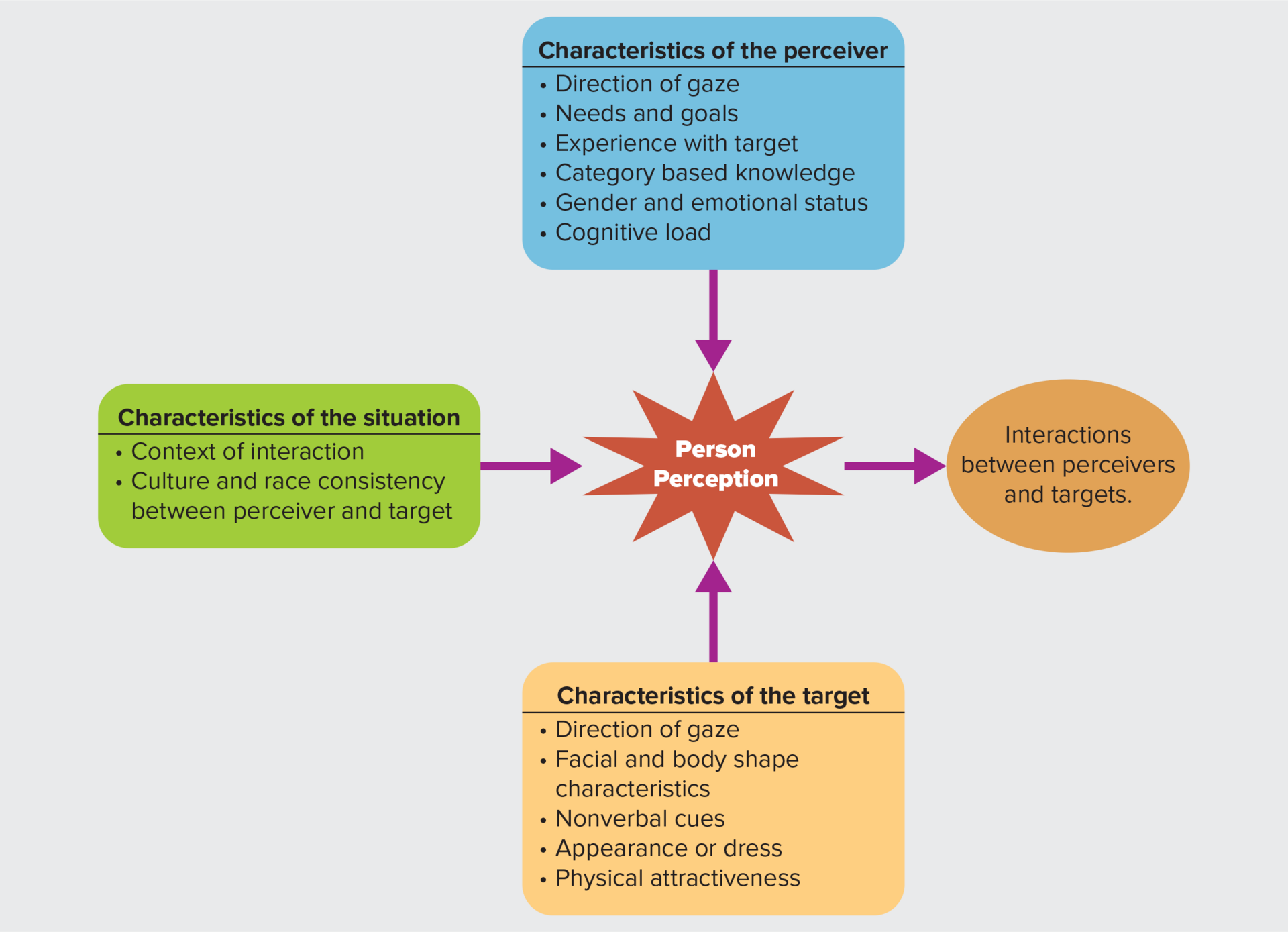Chapter 4: Social Perception and Managing Diversity
1/40
There's no tags or description
Looks like no tags are added yet.
Name | Mastery | Learn | Test | Matching | Spaced |
|---|
No study sessions yet.
41 Terms
Perception
A cognitive process that enables us to interpret and understand our surroundings
How many stages of social perception are there?
4
Stages of Social Perception
Selective Attention/comprehension
Encoding and Simplification
Storage and Retention
Retrieval and Response

Attention
The process of becoming consciously aware of someone or something
Cognitive Categories
Groups of objects that are considered equivalent
Schema
Represents a person’s mental picture or summary of a particular event or type of stimulus
3 key components that influence perception:
Characteristics of the perceiver
characteristics of the situation
Characteristics of the target

Key perceiver characteristics
Direction of gaze
Needs and goals
experience with the target
category-based knowledge
Gender and emotional status
cognitive load
Characteristics of the Target
Direction of gaze
Facial features and body shape
Nonverbal cues
Appearance or dress
physical attractiveness
Characteristics of the Situation
context of interaction
culture and race consistency
Implicit Cognition
Represents any thoughts or beliefs that are automatically activated from memory without our conscious awareness
Stereotype
An individual’s set of beliefs about the characteristics or attributes of a group
How many steps are stereotypes formed in?
4
Steps to form stereotypes
Categorization
Inferences
Expectations
Maintenance
Categorization
Categorizing people into groups according to criteria (such as gender, age, race, and occupation)
Inferences
We infer that all people within a particular category possess the same traits or characteristics (EX; women are nurturing, older people have more job-related accidents)
Expectations
Expectations of others and interpret their behavior according to our stereotypes
Maintenance
Maintaining stereotypes by
overestimating the frequency of stereotypic behaviors exhibited by others
Incorrectly explaining expected and unexpected behaviors
Differentiating minority individuals from ourselves
Casual Attributions
Suspected or inferred causes of behavior
Internal Factors
Factors within a person (such as ability) that are attributed to behavior
External Factors
Factors within the environment (such as a difficult task) that are attributed to behavior
Consensus
Compares a person’s behavior on one task with his or her behavior on other tasks (among people)
Distinctiveness
Compares a person’s behavior on one task with his or her behavior on other tasks (across tasks)
Consistency
Judges whether the individual’s performance on a given task is consistent over time (over time)
Fundamental Attribution Bias
Reflects our tendency to attribute another person’s behavior to his or her personal characteristics, rather than to situational factors
Self-Serving Bias
Represents our tendency to take more personal responsibility for success than for failure
Demographics
The statistical measurements of populations and their qualities (such as age, race, gender, or income)
Diversity
Represents the multitude of individual differences and similarities that exist among people
Surface-level characteristics
Those that are quickly apparent to interactants, such as race, gender, and age
Deep-level characteristics
Those who take time to immerse themselves in interactions, such as attitudes, opinions, and values
Discrimination
Occurs when employment decisions about an individual are based on reasons not associated with performance or related to the job
Affirmative Action
An intervention aimed at giving management a chance to correct an imbalance, injustice, mistake, or outright discrimination that occured in the past
Managing Diversity
Enables people to perform to their maximum potential
Access-and-Legitimacy Perspective
Diversity is based in the recognition that the organization’s markets and constituencies are culturally diverse
Glass Ceiling
Identifies an invisible but absolute barrier that prevents women from advancing to higher-level positions
Americans with Disabilities Act (ADA)
Prohibits discrimination against those with disabilities and requires organizations to reasonably accommodate an individual’s disabilities
Underemployed
Working at jobs that require less education than they have
Diversity Climate
Subcomponent of an organization’s overall climate, and is defined as the employee’s aggregate “perceptions about the organization’s diversity-related formal structure characteristics and informal values”
Psychological Safety
Reflects the extent to which people feel free to express their ideas and beliefs without fear of negative consequences
On-ramping
Programs encourage people to re-enter the workforce after a temporary career break
Ethnocentrism
Based on the feeling that our cultural rules and norms are superior to or more appropriate than the rules and norms of another culture